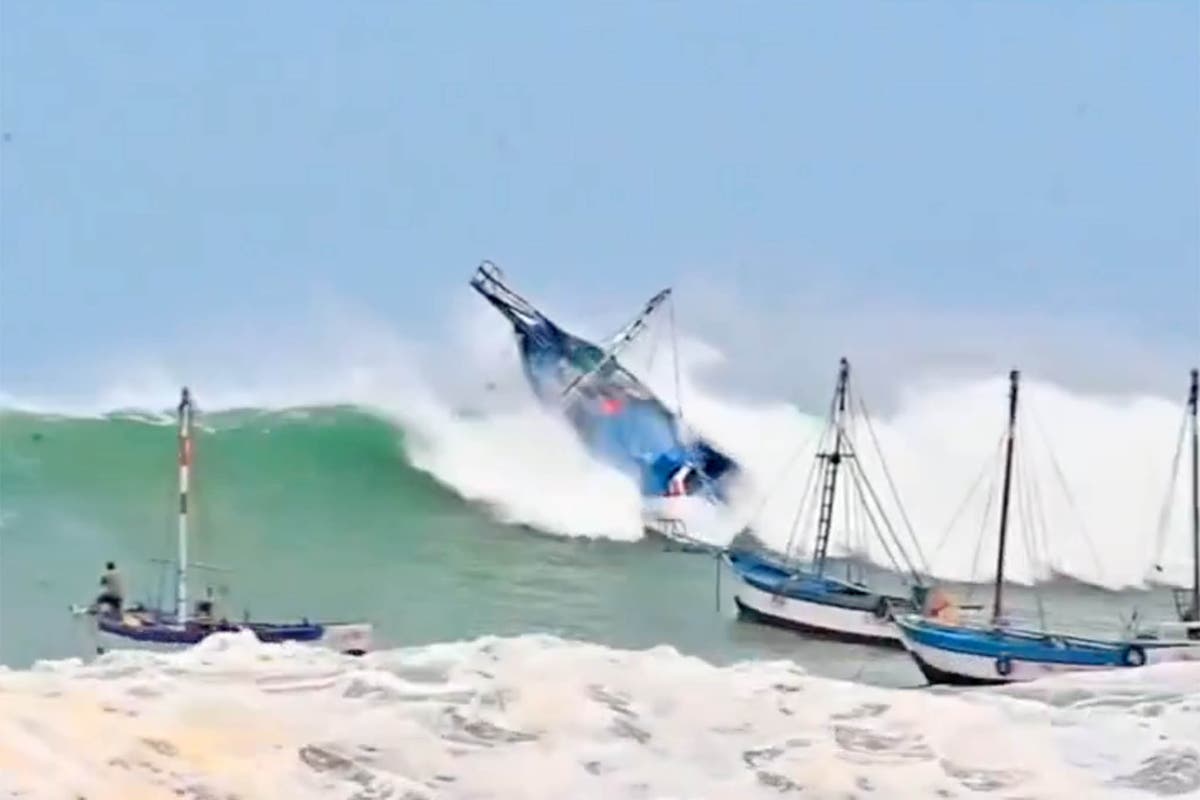A deadly swell struck Peru’s northern coastline triggering tsunami-like waves that ravaged local communities and forcing 75 percent of hte nation’s ports to close, potentially devastating local economies.
The over 13-feet waves crashed onto the shores of Lobitos, Mancora, and Cabo Blanco – 700 miles north of Peru’s capital Lima – Friday from around midday, according to local reports.
The extreme weather phenomenon coincides with the 20th anniversary of the Indian Ocean earthquake and tsunami which struck India, Sri Lanka, Thailand and Indonesia, among other nations, in 2004 killing more than 230,000 people.
Two people were reported to have died in Ecuador’s southwestern Manta region and a 30-year-old man was found dead at a beach in Chile – no deaths have been reported in Peru, according to AFP.
The extreme weather phenomenon came the day after Peru declared an environmental emergency following a shipment from state oil firm Petroperu on December 21 that sent 10,000 square meters of crude oil spilling into the sea, reported Reuters.
open image in galleryThe huge waves have caused significant damage to several beaches in northern Peru (Handout/Samantha Watson)
According to the agency, a vessel that had been carrying out pre-shipment maneuvers caused the crude spill at a terminal in the Talara refinery – just a few miles from the small town of Lobitos.
Petroperu has not yet declared exactly how much oil was spilled.
Enrique Varea, the chief of Hydrography and Navigation for Peru’s Navy, said that three-quarters of all ports in Peru have closed as a result of the forceful waves.
In videos taken by Peruvian locals, huge waves can be seen crashing against “Muelle de Lobitos” – a fishing pier – rattling local fishing boats as the waves hurl towards the shore.
open image in galleryPeru declared an environmental emergency Thursday following a crude oil spill in Talara on December 21 (Mateo Lazo)
Another video shows a huge set of waves broaching a pier on the nearby beach of Cabo Blanco.
The gigantic waves were reportedly triggered by an “extreme event”, according to Ecuador’s secretary for risk management Jorge Carillo.
Carillo warned that possibly more disastrous weather events were to come.
Sebastian Sulca Cordova, 25, told The Independent that locals were alerted to the deadly waves while many had been listening in at a meeting to discuss the disastrous oil spill.
Suddenly, a megaphone announcement called out stating: “Please all fishermen approaching the dock, boats are sinking and friends are drifting away.”
As waves struck and shook the pier, people were knocked down and others were spotted fleeing back to land.
open image in galleryA video captured the moment waves crashed into the roof of the fishing pier Friday (Handout/Samantha Watson)
“The houses are not damaged, but the boats are.
“There are boats that are tied together and lost. We are trying to help find and track what is submerged and get the engines out, which is the most important thing.
“There are entire boats underwater. Yesterday we turned over three boats and took out two engines. Even the water is contaminated with oil and we do what we can and what is within our reach.”
open image in galleryLocal wildlife in the area was found drenched in crude (pictured) along the shores of Lobitos (Mateo Lazo)
Cordova added that locals remain on high alert: “We are awake in case something happens at the dock and they want our help – we are ready at any time.”
Videos taken by locals and NGOs operating in Lobitos showed the despairing consequences of the spill with sealife left smothered in crude and typically pristine sandy beaches tarred black.
The environment ministry declared that at least seven beaches and local wildlife had been affected, said the outlet.
The Independent contacted the Peruvian Navy Coast Guard, the US Embassy in Peru, and Petroperu for comment.
